“Once social change begins, it cannot be reversed. You cannot uneducate the person who has learned to read. You cannot humiliate the person who feels pride. You cannot oppress the people who are not afraid anymore...”
- Cesar Chavez
If the struggle against oppression is that of memory against forgetting, then it is of primary importance that we look to the past to learn about a long line of xenophobic, racist laws that were once widely accepted by the mainstream public. The justification of criminalizing migrants because they are here without documents is immoral and, moreover, the majority are here because they have been displaced due to U.S. foreign trade policies, further implicating the U.S.'s moral responsibility to these economic refugees. Every person has human rights and the right to look for work to support themselves and their family.
UN Secretary-General Ban Ki-moon, declared on December 18, 2008, International Migrants Day:
"...We continue to see the criminalization of irregular migrants. And all too often, migrants are being dealt with primarily from the perspective of security. There is a growing tendency in many parts of the world to subject them to mandatory or prolonged detention, even though human rights law says that detention should be the exception, not the rule.
To save migrants from abuse, and allow them to contribute to development in their home and receiving countries, we must acknowledge them as human beings whose rights, like those of everyone else, must be protected. The best way to do this is to reaffirm the fundamental role of international human rights law as a framework to govern national and international policy.
We commemorate International Migrants Day this year while marking the sixtieth anniversary of the Universal Declaration of Human Rights, with its visionary commitment to dignity and justice for everyone, everywhere, always. We can only fully give meaning to the Declaration if we recognize that, regardless of an individual’s immigration status, fundamental human rights are non-negotiable, and the treatment of migrants, regular and irregular alike, must always conform to international standards...
...People will continue to move from one place to another to live and work. Only by ensuring their protection can we live up to the Declaration’s recognition that “the inherent dignity and of the equal and inalienable rights of all members of the human family is the foundation of freedom, justice and peace in the world”.
Even though most of the laws below were legal in their time, the VAST majority of Americans would not support these laws if introduced today, thus nullifying thier validity based solely on "rule of law" argument and the cliché phrase, "what part of illegal don't you understand?".
It's imperative that people of conscience speak out and act to overturn and rid our country of these types of racist, xenophobic laws.
Brief Overview of Racist Laws:
(in chronological order, click on images to enlarge)
Slavery (1500s - 1865)
 Slavery in the United States existed in North America for more than a century before the founding of the United States in 1776, and continued in the South until the passage of the Thirteenth Amendment to the United States Constitution in 1865. Slavery in the United States existed in North America for more than a century before the founding of the United States in 1776, and continued in the South until the passage of the Thirteenth Amendment to the United States Constitution in 1865.
The first English colony in North America, Virginia, first imported Africans in 1619, a practice earlier established in the Spanish colonies as early as the 1560s. The majority of slaveholders were in the southern United States, where most slaves were engaged in a work-gang system of agriculture. Such large groups of slaves were thought to work more efficiently if directed by a managerial class called overseers, usually white men.
From the 16th to the 19th centuries, an estimated 12 million Africans were shipped as slaves to the Americas. Of these, an estimated 645,000 were brought to what is now the United States. By the 1860 United States Census, the slave population in the United States had grown to four million.
(Source: http://en.wikipedia.org/wiki/Slavery_in_the_United_States)
Top
Fugitive Slave Act of 1793
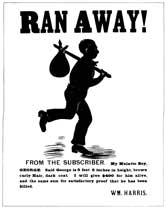 Congress passed the Fugitive Slave Act in February 1793 and this was signed into law by the first US president, George Washington. The Fugitive Slave Clause of the U.S. Constitution (Article 4, Section 2) guaranteed the right of a slaveholder to recover an escaped slave. This law established the legal mechanism by which escaped slaves could be seized in any state, brought before a magistrate and returned to their masters, giving states the right to demand a slave be returned. This law made it a crime to assist a fugitive or a slave in escaping, with prison and a fine for helping a fugitive but only a fine for helping a slave. The Act made every escaped slave a fugitive for life (unless manumited by the owner), who could be recaptured at any time anywhere within the territory of the United States, along with any children subsequently born of enslaved mothers. Congress passed the Fugitive Slave Act in February 1793 and this was signed into law by the first US president, George Washington. The Fugitive Slave Clause of the U.S. Constitution (Article 4, Section 2) guaranteed the right of a slaveholder to recover an escaped slave. This law established the legal mechanism by which escaped slaves could be seized in any state, brought before a magistrate and returned to their masters, giving states the right to demand a slave be returned. This law made it a crime to assist a fugitive or a slave in escaping, with prison and a fine for helping a fugitive but only a fine for helping a slave. The Act made every escaped slave a fugitive for life (unless manumited by the owner), who could be recaptured at any time anywhere within the territory of the United States, along with any children subsequently born of enslaved mothers.
This law had a real effect on slaves all their lives, though some slaveowners were not satisfied with it. One such person was Oney Judge (sometimes spelled Ona), one of Martha Washington's slaves and chambermaids; she served the Washingtons in Virginia and the President's House in Philadelphia during the time the city was the US capital and Washington was President. She escaped on Saturday, May 21, 1796. George Washington made two attempts to seize her shortly afterwards, even enlisting the help of the Secretary of the Treasury Oliver Wolcott jr in a letter written on September 1, 1796. He then tried to use his nephew, but neither attempt was successful, acting in a discreet manner so as to avoid causing controversy.
Furthermore, the slave catching industry grew as a result of this law, returning many slaves to their former owners. This made it more difficult for African Americans whether free or runaways, as slave catchers went after freed blacks too.
There were numerous instances in which people who were legally free and had never been slaves were captured and brought south to be sold into slavery.
One account is that of Solomon Northup. He was born around 1808 to Mintus Northup, who was a legally freed man from in New York state. Solomon was tricked into going to Washington DC, captured and sold into slavery in 1841 to be a slave for 12 years. One of the very few to be restored to freedom under such circumstances, he later sued the men involved but could not give evidence in the case as he was black. The New York Times published an article on this trial on January 20, 1853. His account is "Twelve Years a Slave", and provides his narrative as well as numerous details about the slave trade in Washington DC.
It is available to read by Guttenberg & Google books as the copyright is expired.
(Source: http://en.wikipedia.org/wiki/Fugitive_Slave_Act_of_1793)
Top
The Indian Removal Act of 1830
 Indian removal was a nineteenth century policy of the government of the United States to relocate Native American tribes living east of the Mississippi River to lands west of the river. The Indian Removal Act, part of a United States government policy known as Indian removal, was signed into law by President Andrew Jackson on May 26, 1830. A few tribes went peacefully, but many resisted the relocation policy. Indian removal was a nineteenth century policy of the government of the United States to relocate Native American tribes living east of the Mississippi River to lands west of the river. The Indian Removal Act, part of a United States government policy known as Indian removal, was signed into law by President Andrew Jackson on May 26, 1830. A few tribes went peacefully, but many resisted the relocation policy.
During the fall and winter of 1838 and 1839, the Cherokees were forcibly moved west by the United States government. Approximately 4,000 Cherokees died on this forced march, which became known as the "Trail of Tears."
President Andrew Jackson outlined his Indian removal policy in his Second Annual Message to Congress on December 6, 1830. Jackson's comments on Indian removal begin with the words:
"It gives me pleasure to announce to Congress that the benevolent policy of the Government, steadily pursued for nearly thirty years, in relation to the removal of the Indians beyond the white settlements is approaching to a happy consummation. Two important tribes have accepted the provision made for their removal at the last session of Congress, and it is believed that their example will induce the remaining tribes also to seek the same obvious advantages."
Link to full text of Indian Removal Act here.
(Source: http://en.wikipedia.org/wiki/Indian_Removal_Act)
Top
U.S. Government Suppression of Native-American Religion
 With officials believing in the virtue of Christianity, the United States Government worked to convert American Indians to Christianity and suppress the practice of the Native religions (spiritual leaders had been associated with leading uprisings.) The goal of the United States Government was to get Native Americans to assimilate to their culture. Some called this "making apples", as the Indians would still appear 'red' on the outside, but would be made 'white' on the inside. With officials believing in the virtue of Christianity, the United States Government worked to convert American Indians to Christianity and suppress the practice of the Native religions (spiritual leaders had been associated with leading uprisings.) The goal of the United States Government was to get Native Americans to assimilate to their culture. Some called this "making apples", as the Indians would still appear 'red' on the outside, but would be made 'white' on the inside.
Even in the 20th century, "spiritual leaders ran the risk of jail sentences of up to 30 years for simply practicing their rituals". The law did not change until the passage of the American Indian Religious Freedom Act (AIRFA) of 1978.
(Source: http://en.wikipedia.org/wiki/Americanization_(of_Native_Americans)#Suppression_of_Religion)
Top
Fugitive Slave Act of 1850
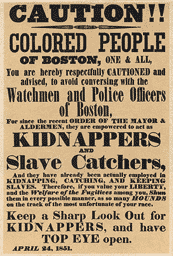 The Fugitive Slave Law or Fugitive Slave Act was passed by the United States Congress on September 18, 1850, as part of the Compromise of 1850 between Southern slave holding interests and Northern Free-Soilers. It declared that all runaway slaves be brought back to their masters. Abolitionists nicknamed it the "Bloodhound Law" for the dogs that were used to track down runaway slaves. The Fugitive Slave Law or Fugitive Slave Act was passed by the United States Congress on September 18, 1850, as part of the Compromise of 1850 between Southern slave holding interests and Northern Free-Soilers. It declared that all runaway slaves be brought back to their masters. Abolitionists nicknamed it the "Bloodhound Law" for the dogs that were used to track down runaway slaves.
In the response to the weakening of the earlier Fugitive Slave Act of 1793, the Fugitive Slave Law of 1850 made any Federal marshal or other official who did not arrest an alleged runaway slave liable to a fine of $1,000. Law-enforcement officials everywhere now had a duty to arrest anyone suspected of being a runaway slave on no more evidence than a claimant's sworn testimony of ownership. The suspected slave could not ask for a jury trial or testify on his or her own behalf. In addition, any person aiding a runaway slave by providing food or shelter was subject to six months' imprisonment and a $1,000 fine. Officers who captured a fugitive slave were entitled to a bonus or promotion for their work. Slave owners only needed to supply an affidavit to a Federal marshal to capture an escaped slave. Since any suspected slave was not eligible for a trial this led to many free blacks being conscripted into slavery as they had no rights in court and could not defend themselves against accusations.
In 1854, the Wisconsin Supreme Court became the only state high court to declare the Fugitive Slave Act unconstitutional, as a result of a case involving fugitive slave Joshua Glover, and Sherman Booth, who led efforts that thwarted Glover's recapture.
Ultimately, in 1859 in Ableman v. Booth the U.S. Supreme Court overruled the state court.
(Source: http://en.wikipedia.org/wiki/Fugitive_Slave_Act_of_1850)
Top
1850 Foreign Miners Tax
This law placed a $20 a month tax on all miners of foreign origin in California. The 1852 version of the law placed a $3 a month tax exclusively for Chinese laborers. Taxes for Chinese steadily increased with ever harsher bills passing the California Legislature and signed into law by then California Governor Bigler. One law passed by the State Legislature and signed by the Governor created a $50 tax per head for Chinese entering Californian ports that was to be paid within three days.
The California Supreme Court later ruled the law unconstitutional.
(Source: http://en.wikipedia.org/wiki/John_Bigler#Anti-Chinese_laws)
Top
"Greaser" Act of 1855
The Greaser Act was an anti-Mexican law enacted in 1855 in California, thinly disguised as an anti-vagrancy statute. The law defined a vagrant as "all persons who are commonly known as 'Greasers' or the issue of Spanish and Indian blood... and who go armed and are not peaceable and quiet persons." The law was repealed a few years later.
(Source: http://en.wikipedia.org/wiki/Greaser_Act)
Top
The Black Codes (1860s)
These were laws passed on the state and local level in the United States, but mostly in the south, to limit the basic human rights and civil liberties of blacks. After the abolition of slavery by the Thirteenth Amendment to the United States Constitution, all former slave states adopted new Black Codes. During 1865 every Southern state passed Black Codes that restricted the Freedmen, who were emancipated but not yet full citizens. While they pursued re-admission to the Union, the Southern states provided freedmen with limited second-class civil rights and no voting rights. Southern plantation owners feared that they would lose their land. Having convinced themselves that slavery was justified, planters feared African Americans wouldn't work without coercion. The Black Codes were an attempt to control them and to ensure they did not claim social equality.
The Black Codes denied freedmen the rights to testify against whites, to serve on juries or in state militias, or to vote. Black Codes declared that freedmen who failed to sign yearly labor contracts could be arrested and hired out to white landowners. Some states limited the occupations open to African Americans and barred them from acquiring land, and others provided that judges could assign African American children to work for their former owners without the consent of their parents.
These are detailed elements of the black codes of Mississippi and South Carolina:
Mississippi:
"Negroes must make annual contracts for their labor in writing; if they should run away from their tasks, they forfeited their wages for the year. Whenever it was required of them they must present licenses (in a town from the mayor; elsewhere from a member of the board of police of the beat) citing their places of residence and authorizing them to work. Fugitives from labor were to be arrested and carried back to their employers. Five dollars a head and mileage would be allowed such negro catchers. It was made a misdemeanor, punishable with fine or imprisonment, to persuade a freedman to leave his employer, or to feed the runaway. Minors were to be apprenticed, if males until they were twenty-one, if females until eighteen years of age. Such corporal punishment as a father would administer to a child might be inflicted upon apprentices by their masters. Vagrants were to be fined heavily, and if they could not pay the sum, they were to be hired out to service until the claim was satisfied. Negroes might not carry knives or firearms unless they were licensed so to do. It was an offence, to be punished by a fine of $50 and imprisonment for thirty days, to give or sell intoxicating liquors to a negro. When negroes could not pay the fines and costs after legal proceedings, they were to be hired at public outcry by the sheriff to the lowest bidder...."
South Carolina:
"In South Carolina persons of color contracting for service were to be known as "servants," and those with whom they contracted, as "masters." On farms the hours of labor would be from sunrise to sunset daily, except on Sunday. The negroes were to get out of bed at dawn. Time lost would be deducted from their wages, as would be the cost of food, nursing, etc., during absence from sickness. Absentees on Sunday must return to the plantation by sunset. House servants were to be at call at all hours of the day and night on all days of the week. They must be "especially civil and polite to their masters, their masters' families and guests," and they in return would receive "gentle and kind treatment." Corporal and other punishment was to be administered only upon order of the district judge or other civil magistrate. A vagrant law of some severity was enacted to keep the negroes from roaming the roads and living the lives of beggars and thieves."
In Texas, the Eleventh Legislature produced these codes in 1866. The intent of the legislation was to reaffirm the inferior position that slaves and free blacks had held in antebellum Texas and to regulate black labor. The codes reflected the unwillingness of white Texans to accept blacks as equals and also their fears that freedmen would not work unless coerced. Thus the codes continued legal discrimination between whites and blacks. The legislature, when it amended the 1856 penal code, emphasized the continuing line between whites and blacks by defining all individuals with one-eighth or more African blood as persons of color, subject to special provisions in the law.
After the 1866 elections, the South was put under military rule. New elections were held in which the Freedmen could vote. Suffrage was also expanded to poor whites. The new governments repealed all the Black Codes; they were never reenacted.
The Black Codes of the 1860s are not the same as the Jim Crow laws. The Black Codes were in reaction to the abolition of slavery and the South's defeat in the Civil War. Southern legislatures enacted them in the 1860s. The Jim Crow era began later, nearer to the end of the 19th century after Reconstruction.
(Source: http://en.wikipedia.org/wiki/Black_Codes_(United_States))
Top
Anti-Coolie Act a.k.a. "An act to protect free white labor against competition with Chinese coolie labor, and to discourage the immigration of the Chinese into the State of California" (1862)
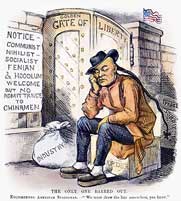 The Anti-Coolie Act was enacted by the state of California in the United States of America and became law on April 26, 1862. Its proper title is "An act to protect free white labor against competition with Chinese coolie labor, and to discourage the immigration of the Chinese into the State of California." It was designed to protect native residents of the state from competition in the labor market from Chinese immigrant manual laborers. It aimed to discourage Chinese citizens from immigrating to California by placing a per capita tax on all Chinese laborers in the state of California. The Anti-Coolie Act was enacted by the state of California in the United States of America and became law on April 26, 1862. Its proper title is "An act to protect free white labor against competition with Chinese coolie labor, and to discourage the immigration of the Chinese into the State of California." It was designed to protect native residents of the state from competition in the labor market from Chinese immigrant manual laborers. It aimed to discourage Chinese citizens from immigrating to California by placing a per capita tax on all Chinese laborers in the state of California.
The tax took the form of a monthly work permit costing $2.50 to be required of any worker over the age of 18 of the "Mongolian Race." The act exempted Chinese workers engaged in the production or manufacture of sugar, rice, coffee or tea. Federal legislation known by the same name was passed earlier the same year. "Coolie" was a derogatory term used for unskilled Asian workers. (You can find the full text of this law as a PDF here)
(Source: http://en.wikipedia.org/wiki/Anti-Coolie_Act)
Top
Convict Lease System (1883-1910)
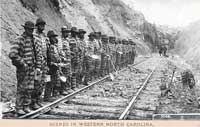 The subjugation of African-Americans became common throughout the South after the war. Several laws were passed (or old ones were reinstituted) which helped keep the African-American population in its place, such as vagrancy, loitering, disturbing the peace, and Jim Crow laws, to name just a few. When these methods failed, the use of force was relied upon, especially lynching (and lynchings increased after the war). One result of this practice was the shift in prison populations to predominately African-American following the war. [Source: Black Commentator] The subjugation of African-Americans became common throughout the South after the war. Several laws were passed (or old ones were reinstituted) which helped keep the African-American population in its place, such as vagrancy, loitering, disturbing the peace, and Jim Crow laws, to name just a few. When these methods failed, the use of force was relied upon, especially lynching (and lynchings increased after the war). One result of this practice was the shift in prison populations to predominately African-American following the war. [Source: Black Commentator]
Convict leasing was a system of penal labour instituted in the American South after the emancipation of slaves by the Thirteenth Amendment to the United States Constitution in 1865. Criminologist Thorsten Sellin, in his book Slavery and the Penal System, says that the sole aim of convict leasing "was financial profit to the lessees who exploited the labor of the prisoners to the fullest, and to the government which sold the convicts to the lessees." Convict leasing involved leasing out prisoners to private companies that paid the state a fee. The convicts worked for the companies during the day (convicts were usually not paid) outside the prison and returned to their cells at night.
The Convict Lease System quickly became widespread and was used to supply labor in railroad, mining, farming, and logging operations. Offenders who were leased out to private enterprises often suffered neglect, abuse, and brutality. Convict leasing began in Texas by 1883 and was abolished in 1910.
(Source: http://en.wikipedia.org/wiki/Convict_lease)
Top
Page Act of 1875
The law was named after Horace F. Page, a Republican Congressman in the United States House of Representatives who introduced the bill and “sought to end the danger of cheap Chinese labor and immoral Chinese women."
(Source: http://en.wikipedia.org/wiki/Page_Act_of_1875)
Top
Residential School Systems - Indian Schools (1879-1900s)
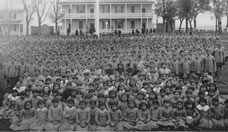 Tens of thousands of American Indians and Alaska Natives were forced to attend a residential school system which sought to reeducate them in white settler American values, culture and economy, to "kill the Indian, save[ing] the man." Tens of thousands of American Indians and Alaska Natives were forced to attend a residential school system which sought to reeducate them in white settler American values, culture and economy, to "kill the Indian, save[ing] the man."
Once Native-American territories were incorporated into the United States, surviving Native Americans were denied equality before the law and often treated as wards of the state. In some areas, these schools were primarily run by missionaries. Especially given the young age of some of the children sent to the schools, they have been documented as traumatic experiences for many of the children who attended them. They were generally forbidden to speak their native languages, taught Christianity instead of their native religions, and in numerous other ways forced to abandon their Indian identity and adopt European-American culture. Tragically, many cases of mental and sexual abuse have been documented, as in North Dakota.
The Meriam Report, officially titled "The Problem of Indian Administration", was prepared for the Department of Interior. Assessments found the schools underfunded and understaffed, too heavily institutionalized, and run too rigidly. What had started as an idealistic program about education had gotten subverted. It recommended:
- Abolishing the "Uniform Course of Study", which taught only majority European-American cultural values;
- Having younger children attend community schools near home, though older children should be able to attend non-reservation schools; and
- Ensuring that the Indian Service provided Native Americans with the skills and education to adapt both in their own traditional communities (which tended to be more rural) and the larger American society.
(View a news article in Milwaukee Sentinel dated July 22, 1894, where a white man praises the transformation of Indian children into "Americans:" Link here)
(Source: http://en.wikipedia.org/wiki/Americanization_(of_Native_Americans)#Native_American_education_and_boarding_schools)
Top
Chinese Exclusion Act of 1882
 The Act excluded Chinese "skilled and unskilled laborers and Chinese employed in mining" from entering the country for ten years under penalty of imprisonment and deportation." Once the Chinese Exclusion Act was finally passed in 1882, California went further in its discrimination against the Chinese by passing various laws that were later held to be unconstitutional. Download Full PDF of original document here (3.6MB) The Act excluded Chinese "skilled and unskilled laborers and Chinese employed in mining" from entering the country for ten years under penalty of imprisonment and deportation." Once the Chinese Exclusion Act was finally passed in 1882, California went further in its discrimination against the Chinese by passing various laws that were later held to be unconstitutional. Download Full PDF of original document here (3.6MB)
(Source: http://en.wikipedia.org/wiki/Chinese_Exclusion_Act)
Case Illustration: San Francisco-born Wong Kim Ark, denied reentry to U.S. upon return from 1894 visit to China.
|
|
Wong Kim Ark’s Departure Statement, November 5, 1894 |
Wong Kim Ark’s Discharge Statement, January 3, 1896 |
Denied reentry to the United States upon his return from an 1894 visit to China, San Francisco-born Wong Kim Ark was detained by the collector of customs in San Francisco. At the U.S. District Court, Mr. Wong filed a habeas corpus action against his detention. Although conceding the fact of Mr. Wong’s birth in San Francisco, the U.S. attorney argued that Mr. Wong was a citizen of China because his parents were born in China.
The U.S. District Court in San Francisco determined that Wong Kim Ark “is a citizen of the United States within the meaning of the citizenship clause of the 14th Amendment.” On March 28, 1898, the Supreme Court upheld the District Court opinion and ruled “a child born in the United States to foreign parents who are subject to U.S. jurisdiction automatically becomes a citizen.”
(Source: http://www.archives.gov/exhibits/documented-rights/exhibit/section2/defining-rights.html)
Top
Dawes General Allotment Act of 1887
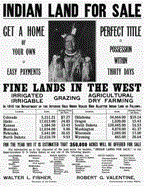 This was enacted by the U.S. Congress regarding the distribution of land to Native Americans in Oklahoma. It was signed into law February 8, 1887. Named after its sponsor, U.S. Senator Henry L. Dawes of Massachusetts, the act was amended in 1891 and again in 1906 by the Burke Act. The act remained in effect until 1934. This was enacted by the U.S. Congress regarding the distribution of land to Native Americans in Oklahoma. It was signed into law February 8, 1887. Named after its sponsor, U.S. Senator Henry L. Dawes of Massachusetts, the act was amended in 1891 and again in 1906 by the Burke Act. The act remained in effect until 1934.
The act provided for the division of tribally held lands into individually-owned parcels and opening "surplus" lands to settlement by non-Indians and development by railroads. By dividing reservation lands into privately-owned parcels, legislators hoped to complete the assimilation process by forcing the deterioration of the communal life-style of the Native societies and imposing Western-oriented values of strengthening the nuclear family and values of economic dependency strictly within this small household unit.
Land allotments were made in exchange for Native Americans' becoming US citizens and giving up some forms of tribal self-government and institutions. It resulted in the transfer of an estimated total of 93 million acres (6,100 km²) from Native American control. Most was sold to individuals.
(Source: http://en.wikipedia.org/wiki/Dawes_Act)
Top
Scott Act (1888)
The Scott Act (1888) was a United States law that prohibited Chinese laborers abroad or who planned future travels from returning. Its main author was William Lawrence Scott of Pennsylvania. It was introduced to expand upon the Chinese Exclusion Act passed in 1882. This left an estimated 20,000-30,000 Chinese outside the United States at the time stranded.
(Source: http://en.wikipedia.org/wiki/Scott_Act_(1888))
Top
Bennett Law of 1889
The Bennett Law was a highly controversial state law passed in Wisconsin in 1889, that required the use of English to teach major subjects in all public and private elementary and high schools. It affected the state's many German-language private schools (and some Norwegian schools), and was bitterly resented by German-American communities.
In 1888 the Republican party nominated William D. Hoard, a dairy farmer with no political experience as governor. He found the opposition of the Germans to the Bennett Law an insult to the English language, and he tried to mobilize the Yankee population of the state behind his reelection in 1890 by hammering at the necessity to have all children speak English. (Most German children were bilingual in the cities and towns, but those in rural areas spoke mostly German.)
Hoard ridiculed the Germans by claiming he was the better guardian of their children than their parents or pastors. Hoard counted votes and thought he had a winning coalition by whipping up nativist distrust of Germania as anti-American. In Milwaukee, a predominantly German city, Hoard attacked Germania and religion. By June, 1890, the state's Missouri Synod and Wisconsin Synod (the main German Lutheran groups) had denounced the law. The law was repealed in 1891, but Democrats used the memories to carry Wisconsin and Illinois in the 1892 presidential election.
(Source: http://en.wikipedia.org/wiki/Bennett_Law)
Top
Geary Act of 1892
Besides renewing the exclusion of Chinese laborers for another 10 years, also required Chinese already in the U.S. to carry a resident permit, a sort of internal passport, that served as proof that they entered the U.S. legally and had the right to remain in the country.
Failure to carry the permit at all times was punishable by deportation or a year of hard labor. In addition, Chinese were not allowed to bear witness in court, and could not receive bail in habeas corpus proceedings.
(Source: http://en.wikipedia.org/wiki/Geary_Act)
Top
Plessy v. Ferguson
(1896)
 In Plessy v. Ferguson, U.S. Supreme Court rules that "separate but equal" treatment for blacks and whites under the law is constitutional, thus institutionalizing Jim Crow laws keeping the races apart in public facilities. In Plessy v. Ferguson, U.S. Supreme Court rules that "separate but equal" treatment for blacks and whites under the law is constitutional, thus institutionalizing Jim Crow laws keeping the races apart in public facilities.
Plessy legitimized the move towards segregation practices begun earlier in the South.The case of Plessy v. Ferguson guaranteed the state's right to implement racially separate institutions requiring them only to be "equal". The prospect of greater state influence in matters of race worried numerous advocates of civil equalities including Supreme Court justice John Harlan who wrote in his dissent of the Plessy decision, "we shall enter upon an era of constitutional law, when the rights of freedom and American citizenship cannot receive from the nation that efficient protection which heretofore was unhesitatingly accorded to slavery and the rights of the master." Harlan's concerns about the entrenchment on the 14th Amendment would prove well founded as states benefited to institute segregation based law that would become popularized as the Jim Crow system.
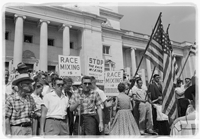 Jim Crow laws spread northward in response to a second wave of African American immigration and would eventually extend to segregated educational facilities, separate public institutions such as hotels and restaurants, separate beaches among other public facilities, restrictions on interracial marriage among numerous other facets of daily life. Jim Crow legislation related to voting would quietly disenfranchise the Southern African American by requiring of prospective voters proof of land ownership or literacy tests at poll stations. Most African Americans were for the most part uneducated former slaves often leasing land from their former owners and immediately lost their constitutionally guaranteed right to participate in the political system. Jim Crow laws spread northward in response to a second wave of African American immigration and would eventually extend to segregated educational facilities, separate public institutions such as hotels and restaurants, separate beaches among other public facilities, restrictions on interracial marriage among numerous other facets of daily life. Jim Crow legislation related to voting would quietly disenfranchise the Southern African American by requiring of prospective voters proof of land ownership or literacy tests at poll stations. Most African Americans were for the most part uneducated former slaves often leasing land from their former owners and immediately lost their constitutionally guaranteed right to participate in the political system.
Historian Rogers Smith noted on the subject "lawmakers frequently admitted, indeed boasted, that such measures as complex registration rules, literacy and property tests, poll taxes, white primaries, and grandfather clauses were designed to produce an electorate confined to a white race that declared itself supreme", notably rejecting the 14th and 15th Amendments to the American Constitution. The "separate but equal" doctrine would characterize American society until the doctrine was ultimately overturned during the 1954 Supreme Court decision of Brown v. Board of Education of Topeka, Kansas.
(Source: http://en.wikipedia.org/wiki/Plessy_v._Ferguson)
Top
Jim Crow Laws (1876-1965)
 This mandated racial segregation in all public facilities, with a supposedly "separate but equal" status for black Americans. Some examples of Jim Crow laws are the segregation of public schools, public places and public transportation, and the segregation of restrooms, restaurants and drinking fountains for whites and blacks. The U.S. military was also segregated. This mandated racial segregation in all public facilities, with a supposedly "separate but equal" status for black Americans. Some examples of Jim Crow laws are the segregation of public schools, public places and public transportation, and the segregation of restrooms, restaurants and drinking fountains for whites and blacks. The U.S. military was also segregated.
(Source: http://en.wikipedia.org/wiki/Jim_Crow_laws)
Top
The Day Law (1904)
In 1904, the "Day Law" was passed by the Kentucky legislature, prohibiting any person, group of people, or corporation from the teaching of black and white students in the same school, or from running separate branches of a school for the teaching of black and white students within twenty-five miles of each other. The law was a direct response to the integrated education provided by Berea College.
After visiting the integrated Berea College, Carl Day, a legislator from Breathitt County, decided that educating blacks and whites together was wrong and began pushing the General Assembly to outlaw the practice. The resulting "Day Law" was enacted in 1904, and was immediately put to the test when the Madison County grand jury indicted the Berea trustees for violating it. The subsequent court case ultimately wound its way, in 1908, to the U.S. Supreme Court. The court upheld the Day Law, though Justice John Marshal Harlan, a Kentuckian, dissented from the majority opinion.
The Day Law remained in effect until 1954, although it was amended in 1948 to allow black nursing and medical students to be educated in medicine at all-white Louisville hospitals. It was finally struck down by the U.S. Supreme Court's Brown v. Board of Education decision, which declared "separate but equal" schools unconstitutional and mandated that education be integrated "with all deliberate speed."
(Source: http://en.wikipedia.org/wiki/Berea_College_v._Kentucky)
Top
Gentlemen's Agreement of 1907
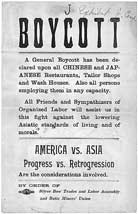 The Gentlemen's Agreement of 1907 (日米紳士協約, Nichibei Shinshi Kyōyaku) was an informal agreement between the United States and the Empire of Japan whereby the U.S. would not impose restriction on Japanese immigration or students, and Japan would not allow further emigration to the U.S. The Gentlemen's Agreement of 1907 (日米紳士協約, Nichibei Shinshi Kyōyaku) was an informal agreement between the United States and the Empire of Japan whereby the U.S. would not impose restriction on Japanese immigration or students, and Japan would not allow further emigration to the U.S.
Anti-Chinese sentiment motivated American entrepreneurs to recruit Japanese laborers. In 1885, the first Japanese workers arrived in the independent Kingdom of Hawaii.
As the Japanese population in California grew they were seen with suspicion of being an entering wedge by Japan. By 1905, anti-Japanese rhetoric filled the pages of the San Francisco Chronicle.
In 1905 the Japanese and Korean Exclusion League was established. The Japanese and Korean Exclusion League established four policies in 1905:
- Extension of the Chinese Exclusion Act to include Japanese and Koreans
- Exclusion by League members of Japanese employees and the hiring of firms that employ Japanese
- Initiation of pressure the School Board to segregate Japanese from white children
- Initiation of a propaganda campaign to inform Congress and the President of this "menace".
(Source: http://en.wikipedia.org/wiki/Gentlemen's_Agreement_of_1907)
Top
Indian Citizenship Act of 1924
Also known as the Snyder Act, was proposed by Representative Homer P. Snyder (R) of New York and granted full U.S. citizenship to America's indigenous peoples, called "Indians" in this Act. (The Fourteenth Amendment guarantees citizenship to persons born in the U.S., but only if "subject to the jurisdiction thereof"; this latter clause excludes certain indigenous peoples.) The act was signed into law by President Calvin Coolidge on June 2.
This Act did not include citizens born before the effective date of the 1924 act, or outside of the United States as an indigenous person. Even Native Americans who were granted citizenship rights under the 1924 Act, may not have had full citizenship and suffrage rights until 1948. According to a survey by the Department of Interior, seven states still refused to grant Indians voting rights in 1938. Discrepancies between federal and state control provided loopholes in the Act's enforcement. States justified discrimination based on state statutes and constitutions.
By 1947 all states with large Indian populations, but Arizona and New Mexico, had extended voting rights to Native Americans that qualified under the 1924 Act. Finally, in 1948 these states withdrew their prohibition on Indian voting because of a judicial decision.
(Source: http://en.wikipedia.org/wiki/Indian_Citizenship_Act_of_1924)
Top
Mexican Repatriation (1929-1939)
The Mexican Repatriation refers to a forced migration that took place between 1929 and 1939, when as many as one million people of Mexican descent were forced or pressured to leave the US. (The term "Repatriation," though commonly used, is inaccurate, since approximately 60% of those driven out were U.S. citizens.) The event, carried out by American authorities, took place without due process. The Immigration and Naturalization Service targeted Mexicans because of "the proximity of the Mexican border, the physical distinctiveness of mestizos, and easily identifiable barrios."
(Source: http://en.wikipedia.org/wiki/Repatriation_Movement)
Top
Indian Termination Policy
Indian termination was the policy of the United States from the mid-1940s to the mid-1960s. The belief was that Native Americans (Indians) would be better off if assimilated as individuals into mainstream American society. To that end, Congress proposed to end the special relationship between tribes and the federal government. The intention was to grant Native Americans all the rights and privileges of citizenship, and to reduce their dependence on a bureaucracy whose mismanagement had been documented. In practical terms, the policy terminated the US government's recognition of sovereignty of tribes, trusteeship of Indian reservations, and exclusion of Indians from state laws. Native Americans were to become subject to state and federal taxes as well as laws, from which they had previously been exempt.
During 1953–1964, 109 tribes were terminated, approximately 1,365,801 acres (5,527 km2) of trust land were removed from protected status, and 13,263 Native Americans lost tribal affiliation. Many scholars believe that the termination policy had devastating effects on tribal autonomy, culture and economic welfare. The lands belonging to the Native Americans, rich in resources, were taken over by the federal government. The termination policy had disastrous effects on the Menominee tribe (located in Wisconsin) and the Klamath tribes (located in Oregon), forcing many members of the tribes onto public assistance roll. Termination had a devastating effect on the Health Care and Education of Indians along with the economic stability of tribes. Along with the end of federal control over land came the end of many federal services which included education and health care.
By 1972 termination clearly had affected the tribes' education. There was a 75 percent dropout rate for the Menominee Tribe. This dropout rate resulted in a generation of Menominee children who had only a ninth grade education. The tribes lost federal support for their schools. The states were expected to assume the role of educating the Indian children.
Terminated tribal children struggled to stay in school and those who did could not even be supported by funds that paid for Indian children to go to school.
The Indian Health Service provided health care for many Indian tribes, but once a tribe was terminated they lost their eligibility. Many tribes no longer had any hospitals and no means to get health care. Many Indians relocated off the reservations during termination and therefore had no health care. When they relocated they were given private health care for six months, but then they had none unless they were close to a city Indian health care facility.
By the early 1960s, some federal leaders began opposing the implementation of any more termination measures, although the administration of President John F. Kennedy did oversee some of the last terminations. Some tribes resisted the policy by filing civil lawsuits. The litigation lasted until 1980, when the issue made its way to the US Supreme Court. The 1974 Boldt Decision was upheld in 1980 to recognize those treaty rights that were lost.
With problems arising in the 1960s several organizations were formed, such as the American Indian Movement (AIM) and other organizations that helped protect the rights of the Indians and their land. In 1975, Congress had implicitly rejected the termination policy by passing the Indian Self-Determination and Education Assistance Act, which increased the tribal control over reservations and helped with the funding of building schools closer to the reservations.
On January 24, 1983, President Ronald Reagan issued an American Indian policy statement that supported explicit repudiation of the termination policy.
(Source: http://en.wikipedia.org/wiki/Indian_termination_policy)
Top
 This was the forced relocation and internment by the United States government in 1942 of approximately 110,000 Japanese Americans and Japanese residing along the Pacific coast of the United States to camps called "War Relocation Camps." Japanese Americans residing on the West Coast of the United States were all interned, whereas in Hawaii, where more than 150,000 Japanese Americans composed nearly a third of that territory's population, 1,200 to 1,800 Japanese Americans were interned. Of those interned, 62% were American citizens. This was the forced relocation and internment by the United States government in 1942 of approximately 110,000 Japanese Americans and Japanese residing along the Pacific coast of the United States to camps called "War Relocation Camps." Japanese Americans residing on the West Coast of the United States were all interned, whereas in Hawaii, where more than 150,000 Japanese Americans composed nearly a third of that territory's population, 1,200 to 1,800 Japanese Americans were interned. Of those interned, 62% were American citizens.
(Source: http://en.wikipedia.org/wiki/Japanese_American_internment)
Top
Operation "Wetback" of 1954
 This was an operation by the United States Immigration and Naturalization Service (INS) to remove about one million undocumented immigrants from the southwestern United States, focusing on Mexican nationals. Tactics employed included going as far as systematic police sweeps of Mexican-American neighborhoods, and random stops and ID checks of "Mexican-looking" people in a region with many Native Americans and native Latinos. This was an operation by the United States Immigration and Naturalization Service (INS) to remove about one million undocumented immigrants from the southwestern United States, focusing on Mexican nationals. Tactics employed included going as far as systematic police sweeps of Mexican-American neighborhoods, and random stops and ID checks of "Mexican-looking" people in a region with many Native Americans and native Latinos.
(Source: http://en.wikipedia.org/wiki/Operation_Wetback)
Top
Lynching
 Lynching, the practice of killing people by extrajudicial mob action, occurred in the United States chiefly from the late 1700s through the 1960s. This type of murder is most often associated with hanging, although it often included burning and various other methods of torture. Only rarely were lynchers punished, or even arrested, for their crimes. Between 1866 and 1940, at least 258 blacks were lynched in Kentucky (the exact number is not known because some cases were never reported). Lynching, the practice of killing people by extrajudicial mob action, occurred in the United States chiefly from the late 1700s through the 1960s. This type of murder is most often associated with hanging, although it often included burning and various other methods of torture. Only rarely were lynchers punished, or even arrested, for their crimes. Between 1866 and 1940, at least 258 blacks were lynched in Kentucky (the exact number is not known because some cases were never reported).
"Legal lynching" was condoned under the public hanging law in effect at the time. Blacks accused of crimes were tried under hostile circumstances, with no real chance to prove guilt or innocence, and swiftly given a death sentence. In other cases, the victims of lynching were not even accused of a specific crime—except, perhaps, that of violating some unwritten social convention. While the Ku Klux Klan did not become a strong force within Kentucky, Klan groups were present along with local vigilante groups, who opposed the advancement of blacks. "White-sheet" intimidation and cross burnings were not uncommon, especially in rural areas. (source)
(Source: http://en.wikipedia.org/wiki/Lynching_in_the_United_States)
Top
Anti-Miscegenation Laws (Inter-racial Marriage Laws)
 In the United States, anti-miscegenation laws (also known as miscegenation laws) were state laws passed by individual states to prohibit miscegenation, nowadays more commonly referred to as interracial marriage and interracial sex. All anti-miscegenation laws banned the marriage of whites and non-white groups, primarily blacks, but often also Native Americans and Asians. In the United States, anti-miscegenation laws (also known as miscegenation laws) were state laws passed by individual states to prohibit miscegenation, nowadays more commonly referred to as interracial marriage and interracial sex. All anti-miscegenation laws banned the marriage of whites and non-white groups, primarily blacks, but often also Native Americans and Asians.
In many states, anti-miscegenation laws also criminalized cohabitation and sex between whites and non-whites. In addition, the state of Oklahoma in 1908 banned marriage "between a person of African descent" and "any person not of African descent", and Kentucky and Louisiana in 1932 banned marriage between Native Americans and African Americans. While anti-miscegenation laws are often regarded as a Southern phenomenon, many northern states had anti-miscegenation laws as well.
(Source: http://en.wikipedia.org/wiki/Anti-miscegenation_laws)
Top
Literacy Tests for Voting
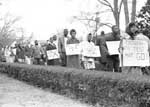 Adopted by a number of southern states, the literacy test was used to disfranchise many literate blacks while allowing many illiterate whites to vote. This was accomplished by making the test inordinately difficult and allowing test-givers to choose who had to take the test and who did not. The literacy test, combined with other discriminatory requirements, effectively disfranchised many African-Americans in the south from the 1890s until the 1960s. Southern states abandoned the literacy test only when forced to do so by federal legislation in the 1960s. Adopted by a number of southern states, the literacy test was used to disfranchise many literate blacks while allowing many illiterate whites to vote. This was accomplished by making the test inordinately difficult and allowing test-givers to choose who had to take the test and who did not. The literacy test, combined with other discriminatory requirements, effectively disfranchised many African-Americans in the south from the 1890s until the 1960s. Southern states abandoned the literacy test only when forced to do so by federal legislation in the 1960s.
The Voting Rights Act of 1965 suspended the use of literacy tests in all states or political subdivisions in which less than 50 percent of voting-age residents were registered as of 1 November 1964 or had voted in the 1964 presidential election. In a series of cases, the Supreme Court of the United States upheld the legislation and restricted the use of literacy tests for non-English-speaking citizens.
(Source: http://en.wikipedia.org/wiki/Literacy_test)
Top
Poll Taxes
A poll tax is a discriminatory tax that is a pre-condition of the exercise of the ability to vote. This tax emerged in some states of the United States in the late 19th century as part of the Jim Crow laws. After the ability to vote was extended to all races by the enactment of the Fifteenth Amendment, many Southern states enacted poll tax laws which often included a grandfather clause that allowed any adult male whose father or grandfather had voted in a specific year prior to the abolition of slavery to vote without paying the tax.
These laws achieved the desired effect of disfranchising African-American and Native American voters as well as poor whites who immigrated after the year specified. The 24th Amendment, ratified in 1964, abolished the use of the poll tax (or any other tax) as a pre-condition in voting in Federal elections.
(Source: http://en.wikipedia.org/wiki/Poll_tax)
Top
Women's Right to Vote (Women's Suffrage)
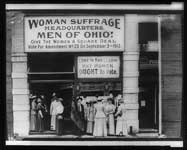 Women's Suffrage is the right of women to vote and to run for office. Following the American Revolution, women were allowed to vote in New Jersey, but no other state, from 1790 until 1807, provided they met property requirements then in place. In 1807, women were again forbidden from voting in the state. Women's Suffrage is the right of women to vote and to run for office. Following the American Revolution, women were allowed to vote in New Jersey, but no other state, from 1790 until 1807, provided they met property requirements then in place. In 1807, women were again forbidden from voting in the state.
During the beginning of the twentieth century, as women's suffrage gained in popularity, suffragists were subject to arrests and many were jailed. Finally, despite President Woodrow Wilson's opposition, Congress passed what became, when it was ratified in 1920, the Nineteenth Amendment which prohibited state and federal agencies from gender-based restrictions on voting.
(Source: http://en.wikipedia.org/wiki/Women's_suffrage#United_States)
Top
Marriage Equality (CURRENT ISSUE)
Same-sex marriage is a universal human rights issue and an issue of equality before the law.
In the United States, although same-sex marriages are not recognized federally, same-sex couples can currently marry in five states (New Hampshire, Iowa, Massachusetts, Vermont and Connecticut) and the District of Columbia and receive state level benefits. Several states, including New York, New Jersey and Rhode Island do not facilitate same-sex marriages, but they do recognize same-sex marriages performed in other jurisdictions. Additionally, several states offer civil unions or domestic partnerships, granting all or part of the state-level rights and responsibilities of marriage.
(Source: http://en.wikipedia.org/wiki/Same-sex_marriage#United_States)
Top |








